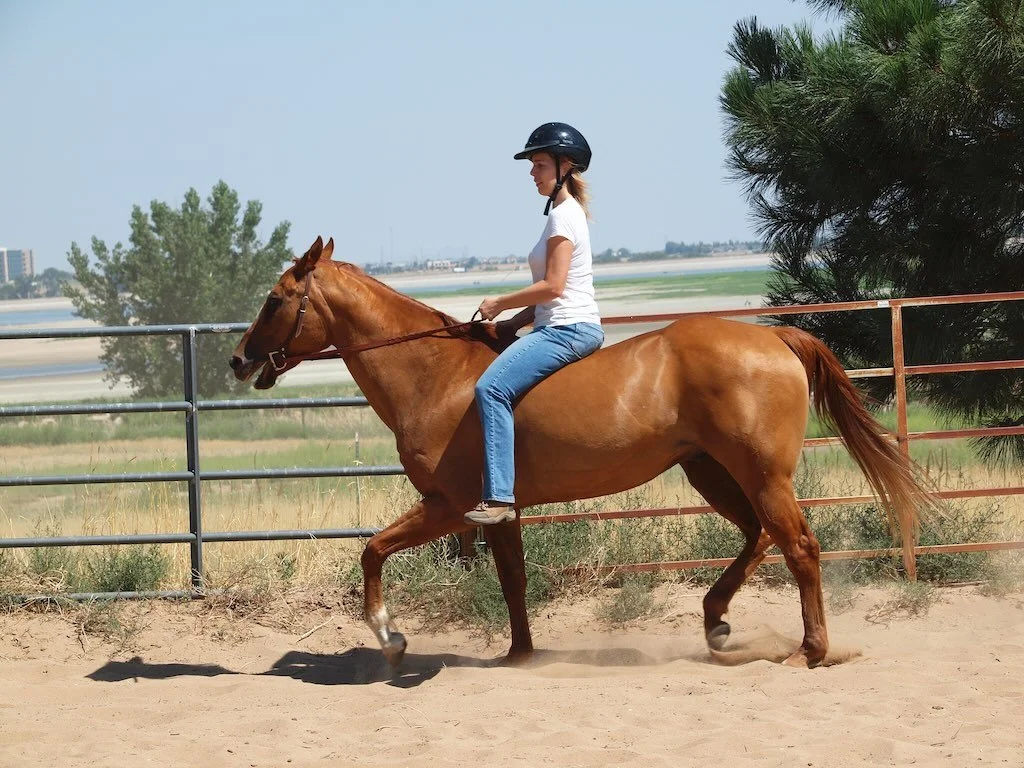What can the braciocephalicus tell us?
The brachiocephalicus can tell us a lot about what is going on in the horse’s front end, so it pays to be able to observe and palpate it.
Palpating the brachiocephalicus.
A lot of insight about how the horse uses his body can be gained from knowing how to observe and palpate certain areas of his body. The neck area can tell us a lot – not just about how the horse uses his neck, but his thoracic sling too. And if you know how he uses his thoracic sling, you can tell a lot about how he uses the rest of the body too. An easy place to start with observing the neck is to watch and palpate the brachiocephalicus muscle. It's the big under neck muscle that, when overdeveloped, can make the horse appear ewe-necked.
The brachiocephalicus is actually two muscles, but for the sake of clarity, we can consider it as one functional unit. It has its origin on the skull and the transverse processes of the first five neck vertebrae. It then runs down the neck and attaches on to the humerus near the shoulder joint. So, we can see it's a pretty long muscle and a massive one too. Therefore, it is easy for the horse to rely too much on this muscle and not enough on its neighbours. What often happens is that the horse starts to overuse this muscle and underuse the muscles of the thoracic sling. They should be the ones the horse primarily relies on when moving the front legs.
A horse overusing his brachiocephalicus.
We see a lot of horses that use this big muscle to literally pull the front leg forward when moving. This becomes very evident when the horse negotiates cavaletti – he will lift the head up high to pull the front leg over the obstacle. He will often have a similar way of executing a transition from walk to trot – he will lift the head up to pull the front legs and start trotting. If this goes on for long enough, the brachiocephalicus will become overdeveloped and tense and the thoracic sling and the upper neck muscles will atrophy and become dysfunctional. When overworked, the brachiocephalicus will most likely become very tense and sensitive. In most cases, you will be able to see that the horse is overusing this muscle just by looking at the muscular development of his front end, but you can confirm this with a palpation test too. Stand to the side of the horse, and have a helper hold the horse. Be aware that palpating the brachiocephalicus can be painful, so be gentle and be prepared for the horse to react unpredictably. Place your palm around the belly of the muscle near the shoulder joint. If your horse is already showing signs of discomfort at this point, this is a red flag. Otherwise, apply a gentle squeeze to the muscle and observe the horse's reaction. If the muscle is painful, most horses will react by lifting their head up high and moving backwards. If this is the case, you need to address the function of the horse's neck and thoracic sling.
The first thing to do is to find the cause of the problem. A tense brachiocephalicus is most likely a symptom, not the actual problem. The cause can be anything from teeth issues, poll tension, unresolved lameness, hoof imbalances, caudal heel pain... After you've identified the problem and started working on resolving it, the next thing to do is to restore function in the neck and thoracic sling. A good bodyworker will help you with that. After any tension and restriction in the area has been dealt with, it's time to teach the horse how to not overuse the lower neck and use the thoracic sling instead. This will consist of slow, controlled work in hand, aimed at re-wiring the nervous system. It might take some time, but you will be rewarded for your patience. Once the horse learns how to properly use his front end, everything will be easier for both you and him.

